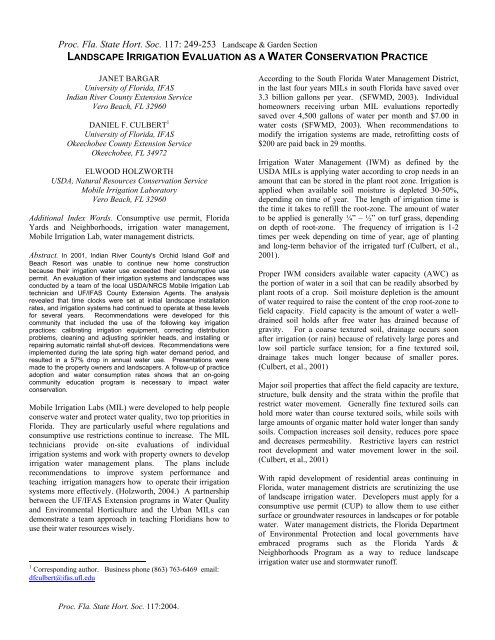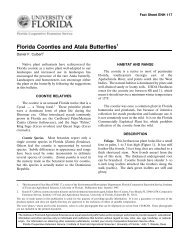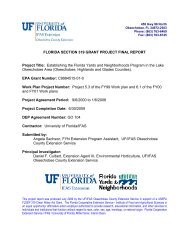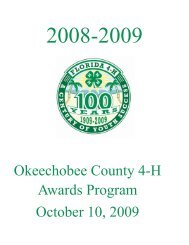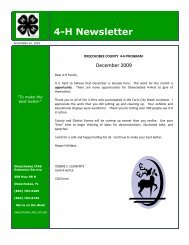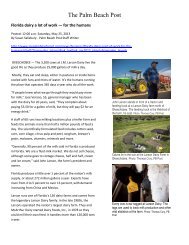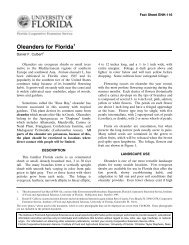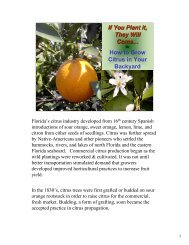landscape irrigation evaluation as a water conservation practice
landscape irrigation evaluation as a water conservation practice
landscape irrigation evaluation as a water conservation practice
Create successful ePaper yourself
Turn your PDF publications into a flip-book with our unique Google optimized e-Paper software.
Proc. Fla. State Hort. Soc. 117: 249-253 Landscape & Garden Section<br />
LANDSCAPE IRRIGATION EVALUATION AS A WATER CONSERVATION PRACTICE<br />
JANET BARGAR<br />
University of Florida, IFAS<br />
Indian River County Extension Service<br />
Vero Beach, FL 32960<br />
DANIEL F. CULBERT 1<br />
University of Florida, IFAS<br />
Okeechobee County Extension Service<br />
Okeechobee, FL 34972<br />
ELWOOD HOLZWORTH<br />
USDA, Natural Resources Conservation Service<br />
Mobile Irrigation Laboratory<br />
Vero Beach, FL 32960<br />
Additional Index Words. Consumptive use permit, Florida<br />
Yards and Neighborhoods, <strong>irrigation</strong> <strong>water</strong> management,<br />
Mobile Irrigation Lab, <strong>water</strong> management districts.<br />
Abstract. In 2001, Indian River County's Orchid Island Golf and<br />
Beach Resort w<strong>as</strong> unable to continue new home construction<br />
because their <strong>irrigation</strong> <strong>water</strong> use exceeded their consumptive use<br />
permit. An <strong>evaluation</strong> of their <strong>irrigation</strong> systems and <strong>landscape</strong>s w<strong>as</strong><br />
conducted by a team of the local USDA/NRCS Mobile Irrigation Lab<br />
technician and UF/IFAS County Extension Agents. The analysis<br />
revealed that time clocks were set at initial <strong>landscape</strong> installation<br />
rates, and <strong>irrigation</strong> systems had continued to operate at these levels<br />
for several years. Recommendations were developed for this<br />
community that included the use of the following key <strong>irrigation</strong><br />
<strong>practice</strong>s: calibrating <strong>irrigation</strong> equipment, correcting distribution<br />
problems, cleaning and adjusting sprinkler heads, and installing or<br />
repairing automatic rainfall shut-off devices. Recommendations were<br />
implemented during the late spring high <strong>water</strong> demand period, and<br />
resulted in a 57% drop in annual <strong>water</strong> use. Presentations were<br />
made to the property owners and <strong>landscape</strong>rs. A follow-up of <strong>practice</strong><br />
adoption and <strong>water</strong> consumption rates shows that an on-going<br />
community education program is necessary to impact <strong>water</strong><br />
<strong>conservation</strong>.<br />
Mobile Irrigation Labs (MIL) were developed to help people<br />
conserve <strong>water</strong> and protect <strong>water</strong> quality, two top priorities in<br />
Florida. They are particularly useful where regulations and<br />
consumptive use restrictions continue to incre<strong>as</strong>e. The MIL<br />
technicians provide on-site <strong>evaluation</strong>s of individual<br />
<strong>irrigation</strong> systems and work with property owners to develop<br />
<strong>irrigation</strong> <strong>water</strong> management plans. The plans include<br />
recommendations to improve system performance and<br />
teaching <strong>irrigation</strong> managers how to operate their <strong>irrigation</strong><br />
systems more effectively. (Holzworth, 2004.) A partnership<br />
between the UF/IFAS Extension programs in Water Quality<br />
and Environmental Horticulture and the Urban MILs can<br />
demonstrate a team approach in teaching Floridians how to<br />
use their <strong>water</strong> resources wisely.<br />
1 Corresponding author. Business phone (863) 763-6469 email:<br />
dfculbert@if<strong>as</strong>.ufl.edu<br />
According to the South Florida Water Management District,<br />
in the l<strong>as</strong>t four years MILs in south Florida have saved over<br />
3.3 billion gallons per year. (SFWMD, 2003). Individual<br />
homeowners receiving urban MIL <strong>evaluation</strong>s reportedly<br />
saved over 4,500 gallons of <strong>water</strong> per month and $7.00 in<br />
<strong>water</strong> costs (SFWMD, 2003). When recommendations to<br />
modify the <strong>irrigation</strong> systems are made, retrofitting costs of<br />
$200 are paid back in 29 months.<br />
Irrigation Water Management (IWM) <strong>as</strong> defined by the<br />
USDA MILs is applying <strong>water</strong> according to crop needs in an<br />
amount that can be stored in the plant root zone. Irrigation is<br />
applied when available soil moisture is depleted 30-50%,<br />
depending on time of year. The length of <strong>irrigation</strong> time is<br />
the time it takes to refill the root-zone. The amount of <strong>water</strong><br />
to be applied is generally ¼” – ½” on turf gr<strong>as</strong>s, depending<br />
on depth of root-zone. The frequency of <strong>irrigation</strong> is 1-2<br />
times per week depending on time of year, age of planting<br />
and long-term behavior of the irrigated turf (Culbert, et al.,<br />
2001).<br />
Proper IWM considers available <strong>water</strong> capacity (AWC) <strong>as</strong><br />
the portion of <strong>water</strong> in a soil that can be readily absorbed by<br />
plant roots of a crop. Soil moisture depletion is the amount<br />
of <strong>water</strong> required to raise the content of the crop root-zone to<br />
field capacity. Field capacity is the amount of <strong>water</strong> a welldrained<br />
soil holds after free <strong>water</strong> h<strong>as</strong> drained because of<br />
gravity. For a coarse textured soil, drainage occurs soon<br />
after <strong>irrigation</strong> (or rain) because of relatively large pores and<br />
low soil particle surface tension; for a fine textured soil,<br />
drainage takes much longer because of smaller pores.<br />
(Culbert, et al., 2001)<br />
Major soil properties that affect the field capacity are texture,<br />
structure, bulk density and the strata within the profile that<br />
restrict <strong>water</strong> movement. Generally fine textured soils can<br />
hold more <strong>water</strong> than course textured soils, while soils with<br />
large amounts of organic matter hold <strong>water</strong> longer than sandy<br />
soils. Compaction incre<strong>as</strong>es soil density, reduces pore space<br />
and decre<strong>as</strong>es permeability. Restrictive layers can restrict<br />
root development and <strong>water</strong> movement lower in the soil.<br />
(Culbert, et al., 2001)<br />
With rapid development of residential are<strong>as</strong> continuing in<br />
Florida, <strong>water</strong> management districts are scrutinizing the use<br />
of <strong>landscape</strong> <strong>irrigation</strong> <strong>water</strong>. Developers must apply for a<br />
consumptive use permit (CUP) to allow them to use either<br />
surface or ground<strong>water</strong> resources in <strong>landscape</strong>s or for potable<br />
<strong>water</strong>. Water management districts, the Florida Department<br />
of Environmental Protection and local governments have<br />
embraced programs such <strong>as</strong> the Florida Yards &<br />
Neighborhoods Program <strong>as</strong> a way to reduce <strong>landscape</strong><br />
<strong>irrigation</strong> <strong>water</strong> use and storm<strong>water</strong> runoff.<br />
Proc. Fla. State Hort. Soc. 117:2004.
One of the many urban developments in Florida is a 412 acre<br />
golf and residential community that h<strong>as</strong> also incorporated<br />
itself <strong>as</strong> a municipality in Indian River County. The Orchid<br />
Island Golf and Beach Club h<strong>as</strong> 156 acres of golf course and<br />
122 acres of residential and common are<strong>as</strong> under <strong>irrigation</strong>.<br />
This community constitutes the major portion of the Town of<br />
Orchid, located on the barrier island north of Vero Beach,<br />
and is an upscale development of single family homes,<br />
courtyard homes and condominiums which include many<br />
recreational amenities that are attractive to affluent retirees.<br />
The St. Johns River Water Management District regulates<br />
<strong>irrigation</strong> <strong>water</strong> use in this area of Florida. Their staff<br />
recommended that Orchid be issued a CUP in February 2000<br />
in the amount of 258.2 million gallons per year (mgy) of<br />
storm<strong>water</strong> and non-potable ground <strong>water</strong> for <strong>irrigation</strong> of the<br />
golf course, residential and common are<strong>as</strong>. (Knight,<br />
McGuire & Associates, 2000.) Of this amount, 77% (198.8<br />
mgy) w<strong>as</strong> designed to come from storm<strong>water</strong> retained in<br />
internal lakes. The balance comes from two 10 inch artesian<br />
wells that draw from the Floridan aquifer from depths of 750<br />
and 800 feet. The permit allows the community’s wells to be<br />
opened only when needed to maintain pond <strong>water</strong> levels,<br />
especially during periods of drought.<br />
This community installed an <strong>irrigation</strong> system that is<br />
segmented into golf course use and residential/common area<br />
systems, each powered by independent pumping stations.<br />
The urban <strong>landscape</strong> use pump h<strong>as</strong> a capacity of 550 gallons<br />
per minute (gpm), and supplies <strong>irrigation</strong> <strong>water</strong> throughout<br />
the 283 home sites and 10 beach condos. This <strong>irrigation</strong><br />
<strong>water</strong> is not metered, and the system costs are handled<br />
through the Property Owners Association (POA). The<br />
residents’ potable <strong>water</strong> is supplied by the county utility<br />
system through individual meters.<br />
Materials and Methods<br />
In January 2001, the County Extension office w<strong>as</strong> <strong>as</strong>ked to<br />
provide <strong>as</strong>sistance to the Orchid Island Golf and Beach Club<br />
with their <strong>irrigation</strong> system. Agents from the local<br />
University of Florida County Extension Service invited the<br />
local urban MIL technician to an initial meeting with<br />
members of the property management team and a POA<br />
representative on January 15, 2001. The property managers<br />
provided an overview of <strong>water</strong> use and rainfall statistics in<br />
the community (Table 1). The <strong>water</strong> use values revealed that<br />
the community w<strong>as</strong> currently using 207% more <strong>water</strong> in the<br />
urban <strong>landscape</strong>s than their CUP allowed despite being at<br />
only 60% build out and with all common area <strong>landscape</strong>s<br />
installed.<br />
Developers and <strong>landscape</strong> managers also revealed that the<br />
urban <strong>irrigation</strong> systems were calibrated to be within 2% of<br />
the manufacturer’s recommended rates at installation.<br />
Application decisions were b<strong>as</strong>ed on the amount of moisture<br />
in the ground. The community <strong>irrigation</strong> system for Orchid’s<br />
homes and common grounds w<strong>as</strong> independent of golf course<br />
<strong>irrigation</strong> system; the operating pressure for these urban uses<br />
w<strong>as</strong> approximately 75 psi in daytime hours, while during<br />
Proc. Fla. State Hort. Soc. 117:2004.<br />
night time high-use periods the pressure often dropped below<br />
20 psi.<br />
There w<strong>as</strong> some concern about salinity of the <strong>irrigation</strong><br />
<strong>water</strong>, especially during drier months when well <strong>water</strong> from<br />
the Florida aquifer would be used. Prior to 2001, a<br />
mysterious clogging of the system w<strong>as</strong> also causing<br />
homeowners to run their systems for longer periods of time,<br />
further dropping <strong>water</strong> pressure and encouraging even longer<br />
run times, further w<strong>as</strong>ting <strong>water</strong>.<br />
The major <strong>as</strong>sistance requested of the Extension/MIL team<br />
w<strong>as</strong> to develop homeowner recommendations on how long to<br />
<strong>water</strong> their <strong>landscape</strong>s. From the perspective of the<br />
developer, the question w<strong>as</strong> how much <strong>water</strong> would be<br />
needed. A member of the POA board noted that a monthly<br />
community newsletter w<strong>as</strong> distributed to all property owners,<br />
and might be a way to get an educational message out to the<br />
community (Tench, 2001).<br />
It w<strong>as</strong> agreed that coring samples would be to taken to<br />
determine soil <strong>water</strong>-holding capacities. Five b<strong>as</strong>ic kinds of<br />
<strong>landscape</strong> plans were found to represent the kinds of homes<br />
present in the development, so that only five <strong>evaluation</strong>s<br />
would be necessary to develop <strong>irrigation</strong> schedules for all<br />
homes in the community. The amount of <strong>water</strong> needed to<br />
irrigate these five lots w<strong>as</strong> then multiplied by the number of<br />
residences of that type to estimate all the <strong>water</strong> needs of the<br />
community.<br />
The team agreed that after <strong>evaluation</strong>s were completed and<br />
recommendations developed that the group would meet again<br />
to review the recommendations. Recommendations would<br />
then be presented at the annual general meeting of the<br />
community’s POA. It w<strong>as</strong> noted that implementation of<br />
these recommendations would be made gradually so that<br />
<strong>landscape</strong> quality would not be affected. Management also<br />
felt that implementation of the <strong>irrigation</strong> schedule could be<br />
done during the springtime, which is the se<strong>as</strong>on with the<br />
highest <strong>irrigation</strong> <strong>water</strong> demand.<br />
The following steps and calculations were used to determine<br />
run times:<br />
1. The number of <strong>irrigation</strong> heads of each pattern (1/4 round,<br />
½ round, full circle, side spray) w<strong>as</strong> counted. Water w<strong>as</strong><br />
collected for a noted amount of time. The following<br />
calculations were then made:<br />
<strong>water</strong>ing rate for each type of head (ml/sec) × 0.016 = n gpm.<br />
number of heads × n gpm = total gpm for that type of spray<br />
pattern.<br />
2. Me<strong>as</strong>urements for each different kind of spray head pattern<br />
produced gpm rates for each zone. These rates were<br />
summed, and the total gpm w<strong>as</strong> divided by the square footage<br />
of the zone. The product w<strong>as</strong> converted to inches per hour by<br />
multiplying by 96.3.
3. The run time for each zone w<strong>as</strong> determined by<br />
multiplying the total iph by 60 minutes to give the minutes of<br />
run time.<br />
After run time and frequency recommendations were<br />
developed, it w<strong>as</strong> recognized that implementation of these<br />
recommendations would also take the involvement of<br />
<strong>landscape</strong> maintenance professionals. At the time that this<br />
project w<strong>as</strong> undertaken seven different <strong>landscape</strong><br />
maintenance companies operated in Orchid. Representatives<br />
of these companies were invited to attend the POA annual<br />
meeting, and copies of the <strong>irrigation</strong> schedule were sent to<br />
these service providers.<br />
One of the participants in the POA meeting w<strong>as</strong> the property<br />
manager of the adjacent development of Windsor. He<br />
indicated that his residents had similar issues with <strong>water</strong><br />
<strong>conservation</strong>. In this community, municipal (potable) <strong>water</strong><br />
w<strong>as</strong> used for <strong>landscape</strong> <strong>irrigation</strong>, and homeowners were<br />
motivated towards <strong>water</strong> <strong>conservation</strong> not by financial<br />
considerations, but by the high volumes of <strong>water</strong> used and<br />
recorded on their individual <strong>water</strong> meters. A second set of<br />
<strong>irrigation</strong> <strong>evaluation</strong>s w<strong>as</strong> conducted by the MIL, and a<br />
second set of <strong>irrigation</strong> run times w<strong>as</strong> recommended to this<br />
community’s management office on August 3, 2001.<br />
A workshop w<strong>as</strong> planned and held for <strong>landscape</strong> maintenance<br />
personnel on September 12, 2001 at Windsor. Thirteen<br />
participants were provided with background information and<br />
reference materials on <strong>irrigation</strong> <strong>water</strong> management and<br />
given hands-on <strong>practice</strong> in using these <strong>irrigation</strong> management<br />
techniques. A tool kit (Table 2) w<strong>as</strong> <strong>as</strong>sembled by the MIL<br />
and given to the property manager’s offices for use by<br />
<strong>landscape</strong> management personnel so they could perform<br />
these <strong>evaluation</strong>s <strong>as</strong> needed.<br />
Results<br />
On January 25, 26 and 29, 2001 the MIL technician and<br />
Horticultural Extension agent worked with the property’s<br />
<strong>irrigation</strong> manager to complete <strong>evaluation</strong>s of five typical<br />
lots. Soil core samples taken showed that the soils consisted<br />
of a coarse yellow sand and slightly finer whiter sand. Cores<br />
taken near the beachfront condos indicated that some marly<br />
shell rock fill existed approximately six inches below grade.<br />
In some c<strong>as</strong>es, soil core samples taken just after <strong>irrigation</strong><br />
had been applied showed wetness below the root-zone,<br />
indicating over-<strong>irrigation</strong>.<br />
Each <strong>irrigation</strong> zone w<strong>as</strong> operated, the number of emitters<br />
w<strong>as</strong> counted, the operating pressures were me<strong>as</strong>ured and the<br />
flow rates were calculated. Square footage of each zone w<strong>as</strong><br />
calculated (Culbert, et al., 2001). Using this information,<br />
<strong>irrigation</strong> run times for five typical lots were calculated<br />
(Table 3).<br />
Frequency of each <strong>irrigation</strong> event needed w<strong>as</strong> determined by<br />
applying <strong>irrigation</strong> <strong>water</strong> management (IWM) principles <strong>as</strong><br />
used by USDA/MIL and University of Florida turfgr<strong>as</strong>s<br />
researchers. For this community, a maximum of two<br />
Proc. Fla. State Hort. Soc. 117:2004.<br />
<strong>irrigation</strong>s per week w<strong>as</strong> suggested <strong>as</strong> a compromise that<br />
would be e<strong>as</strong>y for <strong>landscape</strong> managers to implement, yet<br />
would maintain available <strong>water</strong> capacity and allow for CUP<br />
levels to be followed.<br />
Observations of the <strong>landscape</strong> revealed other issues in this<br />
community that related to their urban <strong>irrigation</strong> <strong>water</strong> use.<br />
Timers were originally set from 15 to 30 minutes per zone<br />
and varied from 3 to 5 to 7 days per week. These settings,<br />
and interviews with homeowners and <strong>landscape</strong>rs, indicated<br />
that most <strong>landscape</strong>s had been installed with timers set to<br />
apply <strong>irrigation</strong> rates typical for newly established plant<br />
materials. It appeared that these delivery rates had not been<br />
adjusted <strong>as</strong> the plants became established. Very little root<br />
growth on St. Augustine turf w<strong>as</strong> noted. Sprinklers<br />
sometimes were obstructed by shrubs, which caused puddling<br />
and runoff onto driveways and roads or resulted in dry spots<br />
in the <strong>landscape</strong>. It w<strong>as</strong> recommended that <strong>landscape</strong>rs and<br />
homeowners observe each zone in operation and adjust<br />
positioning/heights of sprinklers and/or prune shrubs and<br />
gr<strong>as</strong>s to avoid obstruction of spray pattern.<br />
Community <strong>water</strong> use values are summarized in Figure 1.<br />
This figure shows that a drop in consumption of <strong>irrigation</strong><br />
<strong>water</strong> occurred between 2001 and 2002, with the amount in<br />
2002 being 2% less than CUP levels. In 2003, consumption<br />
climbed 47% above permitted amounts.<br />
Climatic records for 2001 showed that the community<br />
received nearly normal rainfall levels, while in 2002, levels<br />
73% above normal were recorded in this community. From<br />
the information available, it is difficult to determine if the<br />
drop in <strong>irrigation</strong> <strong>water</strong> use w<strong>as</strong> due to the <strong>irrigation</strong><br />
recommendations made, or if excessive rainfall w<strong>as</strong> the<br />
major factor in the drop in community <strong>water</strong> use.<br />
A followup <strong>evaluation</strong> of <strong>practice</strong> adoption w<strong>as</strong> conducted in<br />
2004 (Bargar, 2004). Of the 13 workshop participants, none<br />
of those attending were available to respond to questions<br />
about how the workshop may have affected their ability to<br />
evaluate <strong>irrigation</strong> systems. Comments received were that<br />
companies had gone out of business or that workshop<br />
attendees had moved out of the <strong>landscape</strong> maintenance<br />
employment.<br />
Comparing <strong>water</strong> consumption in Figure 1 to staffing<br />
patterns, it is noted that the during the latter part of 2002 the<br />
newly hired Water Quality Extension Agent left the county,<br />
and that the County Extension Director/Horticulture Agent<br />
left this county in 2003. Without staff support, there w<strong>as</strong><br />
little opportunity for continued training of <strong>landscape</strong><br />
maintenance personnel in <strong>irrigation</strong> management, nor w<strong>as</strong><br />
there staff available to monitor and <strong>as</strong>sist these property<br />
managers.<br />
Conclusions<br />
Results from this project allowed the team to determine the<br />
total community <strong>water</strong> use levels, and these figures indicated<br />
fluctuations in consumption and their relationship to the
CUP. The use of these procedures can show <strong>water</strong><br />
management districts, property developers, and property<br />
owners if they are in compliance with these regulations.<br />
Application of these procedures in other communities may<br />
reveal opportunities for property managers to act<br />
immediately on sudden spikes in <strong>water</strong> usage. These<br />
procedures can provide a method for management to<br />
demonstrate compliance with CUPs and request permit<br />
modifications.<br />
It is noted that continuous staffing of those available to<br />
provide <strong>irrigation</strong> education programs may have played a role<br />
in the inability of this community to reduce their <strong>landscape</strong><br />
<strong>irrigation</strong> <strong>water</strong> use. Without on-going programming and<br />
<strong>evaluation</strong>, <strong>irrigation</strong> efficiency and <strong>water</strong> <strong>conservation</strong> may<br />
be a function of weather patterns. Communities committed<br />
to <strong>water</strong> <strong>conservation</strong> will need to provide on-going training<br />
programs and support to property management and POAs to<br />
conserve <strong>water</strong>.<br />
Finally, another recommendation would be for property<br />
managers to "listen to the technicians". In this c<strong>as</strong>e the<br />
<strong>irrigation</strong> specialist indicated to this <strong>evaluation</strong> team the he<br />
had informed management of a problem, but that they were<br />
slow to react. The data in this instance came in monthly<br />
reports. The CUP together with monthly usage figures can<br />
allow management to <strong>as</strong>sess spikes in <strong>water</strong> use, which can<br />
serve to motivate changes in how urban <strong>landscape</strong> <strong>irrigation</strong><br />
systems are operated.<br />
Literature Cited<br />
Bargar, J. 2004. Results of survey regarding Landscape<br />
Irrigation at Windsor. Vero Beach: UF/IFAS Indian River<br />
County Extension Service, May 2004.<br />
Culbert, D., Scotto, L. and Holzworth, E. 2001. Windsor<br />
Water Conservation and Water Quality Workshop. (Program<br />
bulletin.) Vero Beach: Indian River County Extension<br />
Service, 3/20/2001.<br />
Culbert, D. and Holzworth, E. 2001. Water needs and<br />
scheduling of Orchid Island <strong>landscape</strong>s. (PowerPoint<br />
presentation notes.) Vero Beach: UF/IFAS Indian River<br />
County Extension Service, 3/20/2001.<br />
2001. Drought brings <strong>water</strong>-use restrictions to home. Vero<br />
Beach Press Journal, 3/10/2001, p. A7<br />
Holzworth, E. 2004. Mobile Irrigation.Vero Beach, Summer<br />
2000.<br />
Knight, McGuire & Associates. 2000.Orchid Island Gold &<br />
Beach Club - Report on Irrigation. Vero Beach, Summer<br />
2000.<br />
Ibid. Community Water Usage Reports. Orchid: 1999-2004.<br />
South Florida Water Management District (SFWMD). 2003.<br />
Quick Facts on Mobil Irrigation Labs. West Palm Beach, FL.<br />
http://www.sfwmd.gov/images/pdfs/spl<strong>as</strong>h/spl_mobile_irrig.<br />
pdf<br />
Tench, J. R. 2001. The Overlook. Orchid: Orchid Island Golf<br />
& Beach Club, February 2001. (Monthly community<br />
newsletter).<br />
Table 1 - Annual Urban Water Use - Orchid Island Golf & Beach Club, 1999-2003<br />
Percent of<br />
Year Net <strong>water</strong> use z Permitted <strong>water</strong> use z Annual use<br />
over permitted z<br />
permitted<br />
<strong>water</strong> use<br />
Annual rainfall yw<br />
Percent of normal<br />
rainfall x<br />
1999 160,192,000 110,789,000 49,403,000 5% 47.28 -8.03%<br />
2000 215,818,000 110,789,000 105,029,000 95% 44.33 -13.77%<br />
2001 340,321,000 110,789,000 229,532,000 207% 52.35 1.82%<br />
2002 108,474,000 110,789,000 -2,315,000 -2% 89.15 73.40%<br />
2003 155,822,301 110,789,000 45,033,301 41% 47.97 -6.69%<br />
z <strong>water</strong> in gallons<br />
y rainfall in inches<br />
x b<strong>as</strong>ed on normal rainfall of 51.51” (NOAA)<br />
w values for 1999-2001 from Bayer Labs, Vero Beach; 2002-03 values from Orchid Island (on-site)<br />
Proc. Fla. State Hort. Soc. 117:2004.
Table 2 - Irrigation <strong>evaluation</strong> tool kit<br />
soil core sampling tool<br />
pl<strong>as</strong>tic gallon jug - catch bottle<br />
stopwatch<br />
graduated cylinder - me<strong>as</strong>uring device<br />
calculator<br />
special hose and saddle<br />
pressure gauge<br />
me<strong>as</strong>uring tape or wheel<br />
laminated worksheet with formul<strong>as</strong><br />
Figure 1 – Net Water Use<br />
Net Water Use<br />
400,000,000<br />
350,000,000<br />
340,321,000<br />
300,000,000<br />
250,000,000<br />
215,818,000<br />
gallons<br />
200,000,000<br />
150,000,000<br />
160,192,000<br />
155,822,301<br />
108,474,000<br />
100,000,000<br />
50,000,000<br />
0<br />
1999 2000 2001 2002 2003<br />
Annual total<br />
Proc. Fla. State Hort. Soc. 117:2004.
Table 3 - Orchid Island Irrigation System Evaluations<br />
Proc. Fla. State Hort. Soc. 117:2004.


